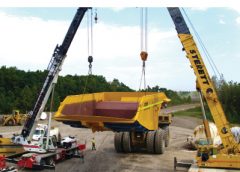By Josh Swank
Maximizing output and productivity are main objectives for every operation. For off-highway hauling, volumetric capacity, weight distribution, heaping and other factors can limit the productivity of standard truck bodies. To get the most out of a truck, it’s important to consider the size and type of equipment used for loading, an operation’s haul cycles, and the materials being hauled.
|
|
| Customized haul truck bodies, such as these designed by Philippi-Hagenbuch, can increase productivity by taking into account specific load characteristics. |
Rock, coal, oil sands, dirt and refuse all have varying densities and characteristics that make it virtually impossible to design a single, standard body that’s ideal for every application. To optimize output, businesses often turn to custom manufacturers to match materials with truck designs, creating truck bodies that fit their specific operations.
The first step in engineering a truly custom truck body is for the manufacturer to work with the customer to understand the characteristics of the materials being hauled and then consider how the materials will pile or heap inside the truck body. Typical bodies are designed around a single angle of repose, or the angle of maximum slope at which a heap of any solid material will stand without sliding over itself. For example, overburden generally heaps at 2-to-1 while coal has a ratio closer to 3-to-1.
In a predictive load modeling process, multiple angles of repose are obtained by examining photographs and 3-D scans of material as it lies in a truck. This data is used to simulate a load profile. During the simulation, the load is put into a virtual bed and moved around to achieve optimal distribution of weight and center of gravity. Engineers can then modify the body design to support load-bearing areas while minimizing steel in areas that don’t require extra support.
Angles of repose aren’t the only characteristic affecting a truck body’s design. Weight plays a critical role for most applications – and the concerns extend beyond the rated capacity of a truck. It’s not uncommon for generic truck bodies to underhaul by 10 to 15 percent when transporting certain materials. To maximize productivity, the truck body must be designed to achieve the optimal volumetric capacity, carrying enough material to reach, but not exceed, the truck’s maximum gross vehicle weight rating.
Custom bodies can also be designed to meet unique challenges posed by different off-highway sites. From tunnels and overhead obstacles to the specific loading equipment and conditions, site-specific requirements need to be taken into consideration when designing custom bodies. The width and height of the bodies can be engineered to work with different loading equipment. Sizing a truck body to complement the bucket capacity and length of a loader can help prevent spillage and maximize the equipment’s capability.
For improved off-loading efficiency, operations may choose to add special liners to the floor and corners of the body to prevent materials from sticking. Another option for improved off-loading is rear-eject bodies, which push material out with a blade while leaving the truck bed down. This can enhance productivity while also providing a safer alternative to end dump bodies in certain environments.
As the benefits of these small details add up, the results can go a long way toward boosting efficiency, productivity and profits as well as the longevity of a haul truck body. For efficient material management using off-highway trucks, consider dumping standard truck bodies for a custom approach.
Josh Swank, vice president of sales and marketing, is a 16-year Philippi-Hagenbuch associate. Swank oversees the sales group and all company marketing efforts. Philippi-Hagenbuch Inc., has been building equipment for off-highway haul trucks since 1969 and has become a global leader in off-highway truck customization. www.philsystems.com.

